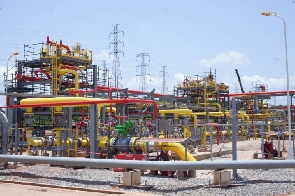 LNG will be supplied under a long-term contract with Shell
LNG will be supplied under a long-term contract with Shell
A floating regasification unit (FRU) that will allow Ghanaian customers to access Liquified Natural Gas (LNG) in the first quarter of 2021 is expected to arrive in the country on Thursday.
The purpose-built FRU, which was built by Jiangnan Shipbuilding, a subsidiary of China State Shipbuilding Corporation, left the Jiangnan shipyard at the end of November.
It is being delivered to the Tema LNG Terminal Company (TLTC), the first offshore LNG receiving terminal in sub-Saharan Africa, which is backed by two UK-based Africa-focused investment firms, Helios Investment Partners, and Africa Infrastructure Investment Managers (AIIM).
The terminal will use a combination of the FRU twinned with an existing LNG carrier to receive, store and regasify LNG, according to the companies involved.
They said in a press release that the system would provide Ghana with “all the functionality of a large scale FRU-terminal, but with added flexibility, allowing it to respond to rapidly increasing domestic gas demand with a cleaner and more affordable energy solution”.
Industry experts see this development as part of the process of securing Africa’s energy future in the wake of the COVID-19 pandemic.
The International Energy Agency (IEA) noted that in sub-Saharan Africa the pandemic had put almost seven years of progress into reverse, with the number of citizens lacking electricity rising to more than 590 million this year, an increase of 13 million people.
At the same time, the IEA pointed out, Africa’s energy demands up to 2040 were set to grow twice as fast as the global average to support the continent’s economic transformation.
“This rapid increase in demand will present new challenges: raising adequate investment; managing growing import dependence; and mitigating the environmental impact of energy production and use,” the IEA said.
Edmund Agyeman-Duah, the project manager at TLTC, said: “The Tema LNG terminal aims to meet Ghana’s growing energy demand through an innovative yet cost-efficient, reliable supply.
“Once operational, this FRU will allow the Tema LNG facility to receive, regasify, store and deliver roughly 1.7 million tonnes of LNG a year – 30 per cent of Ghana’s general capacity. “Tema LNG’s year-round supply of gas will enable the Ghana National Petroleum Corporation to supply reliable and cost-effective gas into the Tema power and industrial enclave, while strengthening West Africa’s energy security,” he added.
The FRU will be located within the Tema Port, where TLTC has built additional marine infrastructure that will allow for cost-efficient LNG loading and regasification without affecting maritime and port traffic in the Gulf of Guinea.
LNG will be supplied under a long-term contract with Shell.
The onshore reception facilities will receive the gas from the FRU via subsea pipelines, before delivering natural gas to customers.
Ogbemi Ofuya of Helios Investment Partners said: “The Tema LNG terminal project supports Ghana’s ambitions to continue on its trajectory as one of the fastest growing economies in Africa, by delivering the energy infrastructure to support accelerated industrialisation.
“As evidenced in similar fast-growing economies in Asia and Latin America, the introduction of LNG into the energy mix serves as a catalyst for industrial and economic growth.
“The year-round, guaranteed supply of LNG and piped gas through the Tema LNG terminal facilitates forward planning and investments in receiving infrastructure by power plants, mines and industries across the West Africa region who are currently reliant on more expensive liquid fuels,” he added.
An added advantage, the companies involved said, was that the switch to gas would deliver a “significant environmental benefit and supports the transition to cleaner burning fuels in the region by reducing CO2 emissions and eliminating sulphur emissions, in line with the Paris Climate Accord objectives”.